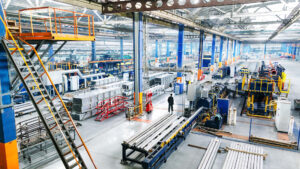Recent years have shown that the global economy has become an increasingly unstable place – this is especially true when it comes to energy.
Instability caused by foreign actors has led to an energy crisis in the UK, which has in turn been reflected in raised bills for both workers and employers. The average cost of bills for a small-to-medium-sized enterprise (SME) rose exponentially in 2022, with fluctuations still felt to this day.
Small businesses reported an increase of nearly 250% in energy costs between 2021 and 2022, rising from approximately £500 to £1,500 per month. This financial burden is unsustainable and clearly anti-growth – an issue of priority for the new Labour government with its focus on economic growth and pro-business investment strategies.
Energy independence from the global fuel market is more important now than ever, prompting the government to announce many renewable energy policies with an investment strategy covering both private and public funding to help UK businesses.
The publicly-owned Great British Energy plans to “generate 8 GW of renewable power by 2030 and create approximately 650,000 jobs in the renewable sector,” and the government has recently secured private funding for offshore wind farms – Orsted (£8bn) and Greenvolt (£2.5bn) – at the UK Investment Summit.
These are changes and plans that – while positive – businesses likely won’t see reflected in their bills for some time. So, what about the businesses that have already taken it upon themselves to make the shift to sustainability?
Businesses have no time to lose in the race for energy security, so we spoke to the asset finance experts at Anglo Scottish about how businesses are financing the shift towards green, UK-based renewable energy.
Key findings
- 1.2m rooftops currently feature solar panels in the UK.
- The average cost for an SME to install commercial solar panels is £16,000-£70,000 in the UK.
- Most medium-sized businesses use 30,000 to 50,000kWh of electricity per year.
- A 50kW solar system worth £33,000 to £60,000 will pay for itself in three to five years.
- British consumers are 58% more likely to buy products and services from green businesses.
- Ambic Manufacturing is forecast to save £1.94m over the next 25 years after financing the switch to green energy.
Challenges and barriers to making the green energy switch
It’s time to talk about the elephant in the room – money. Charlotte Enright, Renewables Specialist at Anglo Scottish, spoke to us about the perceived growing pains of businesses wishing to switch to green energy.
“The initial cost of making the switch to green energy can be off-putting to some businesses, especially those that rely on a steady cash flow year-round. These businesses typically want to hold on to their financial reserves, and sometimes struggle with the thought of making a large investment which won’t pay off immediately,” says Enright.
“Depending on the scale of your operations, the type of renewable energy you invest in may be less expensive than you think. The cost of investing in green energy depends on the type of renewable energy used and this cost can be spread across an extended period, thanks to green energy finance,” Enright continues. “Your business could install anything from a heat pump and solar panels to a small wind turbine – it all depends on the scale of your business and how soon you want to see a return on your investment.
“Solar energy is a particularly attractive solution for businesses that prioritise scalability, as more solar panels can be fitted to match expanding operations. 1.2m rooftops currently feature solar panels in the UK, and this number continues to rise year-on-year.”
It’s not just cost that can daunt businesses from making the switch, however. Access to finance and navigating environmental regulations dissuade some businesses from making the switch, often to the detriment of both the business and the planet.
“Historically, private investment in sustainability has been fairly tentative, due to the worry that certain benefits and schemes designed to encourage net-zero targets would be discontinued as a political choice,” says Enright. “Since 2015, we’ve had six prime ministers all with different priorities for renewable energy. The current government has made it clear that renewables will be an investment pillar for the UK, pledging net zero by 2030 – giving businesses confidence that they will see further viability in switching to renewable energy for at least one election term,” Enright explains.
“What’s more, many businesses are unfamiliar with what they are searching for when it comes to green energy finance. That’s where leaning on specialist brokers and fellow business people who have already made the switch can help.”
Is shifting to green energy worth the investment?
The average cost for an SME to install commercial solar panels is £16,000-£70,000 in the UK. These prices are wide in range due to factors such as roof size, the type of solar panel and how much energy the company needs to cover their output.
Most medium-sized businesses use 30,000 to 50,000kWh of electricity per year, meaning businesses should begin by identifying how much energy they need, in order to install an appropriate amount of panels. If you do produce slightly more power than needed, this energy will not be wasted – in fact, it can actually benefit your business.
“Businesses looking to take advantage of renewable energy for long-term savings may occasionally generate more energy than needed, but this can be a great problem to have. Businesses can export excess power to the grid through the Smart Export Guarantee (SEG) scheme,” says Carl Johnson, UK Sales Director at Anglo Scottish. “The scheme pays businesses for their unused energy, as long as the business meets the requirement of using a system with a capacity of up to 5mW.”
The sooner a business invests in green energy, the sooner it will reap the benefits. The average cost of a 50kW solar system is £33,000 to £60,000, a cost which will pay for itself in three to five years.
“The prospect of being energy self-sufficient is understandably desirable for any business,” says Johnson. “The ROI when financing the switch to green energy is actually quite affordable, as facilities like Green loans and Power Purchase Agreements (PPAs) allow businesses to spread out the cost of adopting green energy, while still benefitting from immediate savings on electricity bills.
“Not to mention, businesses that are environmentally conscious are seen as favourable to British customers,” Johnson continues. “British consumers are 58% more likely to buy products and services from green businesses, so the benefits of financing the shift to sustainability go well beyond saving on bills.”
Success stories in green energy switching
“Ambic Manufacturing, a contract furniture manufacturer, is one example in which an advanced manufacturing firm managed to make the switch to renewables through financing, leading to increased stability and growth for the business,” says Johnson. “They found that increasing the capacity of their solar system would allow them to become entirely energy self-sufficient. In total, Ambic is now forecast to save £1.94m over the next 25 years.”
How your business can finance the switch
Renewable Specialist Charlotte Enright has seen businesses finance their switch to renewable energy in many different ways:
“Green loans are a fantastic way of financing the switch to sustainable energy,” says Enright. “Many banks and financial institutions offer green loans and they have better interest rates than typical commercial loans as they are designed to encourage sustainability. You will often find that they have more flexible repayment terms, offering longer repayment periods that align with your newfound energy savings. This makes green loans very accessible.
“Power Purchase Agreements (PPA) are also an option worth considering. PPAs allow businesses to finance energy systems without the upfront capital – essentially allowing a third-party developer to install and maintain a renewable energy system on the business’s property,” Enright explains. “The business then agrees to purchase the electricity generated at a fixed, reduced rate. The third-party ownership of the system means that the business avoids any responsibility for repairing it. Instead, the business can enjoy fixed, reduced energy costs and the positive reputation associated with renewable energy investment.
“There are also plenty of government grants and incentives which help ease the switch, including the previously mentioned Smart Export Guarantee,” says Enright. “Advanced manufacturing businesses in particular should take advantage of R&D tax credits for financial relief if applicable to their business operations.”
Has your business considered making the switch to renewable energy? The sooner you take the plunge, the sooner you will begin to save. Make sure you consider all the options available to you before investing and always take financial advice from trusted lenders or brokers.






